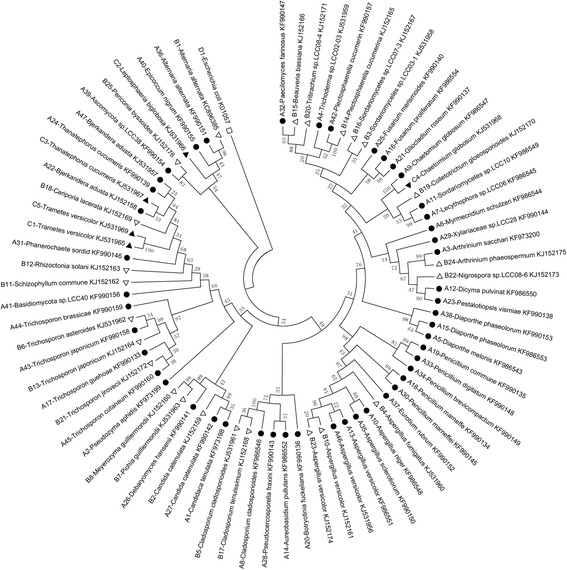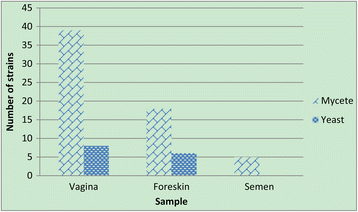Isolation and identification of culturable fungi from the genitals and semen of healthy giant pandas (Ailuropoda melanoleuca)
- PMID: 29157237
- PMCID: PMC5697420
- DOI: 10.1186/s12917-017-1231-0
Isolation and identification of culturable fungi from the genitals and semen of healthy giant pandas (Ailuropoda melanoleuca)
Abstract
Background: In order to better understand the possible role of fungi in giant panda reproduction and overall health, it is important to provide a baseline for the normal fungal composition in the reproductive system. Using morphology and internal transcribed spacer (ITS) sequence analysis, we systematically isolated and identified fungal species from the vagina, foreskin, and semen of 21 (11 males and 10 females) healthy giant pandas to understand the normal fungal flora of the genital tracts.
Results: A total of 76 fungal strains were obtained, representing 42 genera and 60 species. Among them 47 fungal strains were obtained from vaginal samples, 24 from foreskins, and 5 from semen samples. Several fungal strains were isolated from more than one sample. More fungal species were isolated from females from males. The predominant genera were Aspergillus, Trichosporon, and Penicillium, followed by Candida, Cladosporium, Sordariomycetes, and Diaporthe. The average number of strains in the female vagina was significantly higher than in the foreskin and semen of male.
Conclusions: A total of 60 fungal species (belonging to 42 genera) were identified in the giant panda's genital tract. Some of the species were commonly shared in both males and females. These findings provide novel information on the fungal community in the reproductive tracts of giant pandas.
Keywords: Culturable fungi; Foreskin; Giant panda (Ailuropoda melanoleuca); Semen; Vagina.
Conflict of interest statement
Ethics approval and consent to participate
All animal experiments were approved by the Institutional Animal Care and Use Committee of the Sichuan Agricultural University (permit number DYY-S20122106). Permissions were obtained from the Chengdu Research Base of Giant Panda Breeding prior to sample collection from the pandas.
Consent for publication
Not applicable.
Competing interests
The authors declare that they have no competing interests.
Publisher’s Note
Springer Nature remains neutral with regard to jurisdictional claims in published maps and institutional affiliations.
Figures


Similar articles
-
Analysis of the influence of living environment and age on vaginal fungal microbiome in giant pandas (Ailuropoda melanoleuca) by high throughput sequencing.Microb Pathog. 2018 Feb;115:280-286. doi: 10.1016/j.micpath.2017.12.067. Epub 2017 Dec 30. Microb Pathog. 2018. PMID: 29294370
-
NORMAL VAGINAL BACTERIAL FLORA OF GIANT PANDAS (AILUROPODA MELANOLEUCA) AND THE ANTIMICROBIAL SUSCEPTIBILITY PATTERNS OF THE ISOLATES.J Zoo Wildl Med. 2016 Mar;47(1):374-8. doi: 10.1638/2015-0203.1. J Zoo Wildl Med. 2016. PMID: 27010307
-
NORMAL VAGINAL BACTERIAL FLORA OF GIANT PANDAS (AILUROPODA MELANOLEUCA) AND THE ANTIMICROBIAL SUSCEPTIBILITY PATTERNS OF THE ISOLATES.J Zoo Wildl Med. 2016 Jun;47(2):671-5. doi: 10.1638/2015-0203a.1. J Zoo Wildl Med. 2016. PMID: 27468049
-
Comprehensive Breeding Techniques for the Giant Panda.Adv Exp Med Biol. 2019;1200:275-308. doi: 10.1007/978-3-030-23633-5_10. Adv Exp Med Biol. 2019. PMID: 31471801 Review.
-
Giant pandas are not an evolutionary cul-de-sac: evidence from multidisciplinary research.Mol Biol Evol. 2015 Jan;32(1):4-12. doi: 10.1093/molbev/msu278. Epub 2014 Oct 1. Mol Biol Evol. 2015. PMID: 25274274 Review.
Cited by
-
High-throughput sequencing and characterization of potentially pathogenic fungi from the vaginal mycobiome of giant panda (Ailuropoda melanoleuca) in estrus and non-estrus.Front Microbiol. 2024 Jan 25;15:1265829. doi: 10.3389/fmicb.2024.1265829. eCollection 2024. Front Microbiol. 2024. PMID: 38333585 Free PMC article.
-
Metagenome-validated combined amplicon sequencing and text mining-based annotations for simultaneous profiling of bacteria and fungi: vaginal microbiota and mycobiota in healthy women.Microbiome. 2024 Dec 28;12(1):273. doi: 10.1186/s40168-024-01993-9. Microbiome. 2024. PMID: 39731160 Free PMC article.
-
Food Habit Associated Mycobiota Composition and Their Impact on Human Health.Front Nutr. 2021 Nov 22;8:773577. doi: 10.3389/fnut.2021.773577. eCollection 2021. Front Nutr. 2021. PMID: 34881282 Free PMC article. Review.
-
Assessment of the pulmonary adaptive immune response to Cladosporium cladosporioides infection using an experimental mouse model.Sci Rep. 2021 Jan 13;11(1):909. doi: 10.1038/s41598-020-79642-y. Sci Rep. 2021. PMID: 33441700 Free PMC article.
-
Skin Microbiota of the Captive Giant Panda (Ailuropoda Melanoleuca) and the Distribution of Opportunistic Skin Disease-Associated Bacteria in Different Seasons.Front Vet Sci. 2021 Jul 5;8:666486. doi: 10.3389/fvets.2021.666486. eCollection 2021. Front Vet Sci. 2021. PMID: 34291099 Free PMC article.
References
-
- Peng J, Jiang Z, Hu J. Status and conservation of giant panda (Ailuropoda Melanoleuca): a review. Folia Zool. 2001;50(2):81–88.
-
- Ran J, Du B, Yue B. Conservation of the endangered giant panda Ailuropoda Melanoleuca in China: successes and challenges. Oryx. 2009;43(02):176–178. doi: 10.1017/S0030605309432010. - DOI
-
- Lockhart SR, Pham CD, Gade L, Iqbal N, Scheel CM, Cleveland AA, Whitney AM, Noble-Wang J, Chiller TM, Park BJ, et al. Preliminary laboratory report of fungal infections associated with contaminated methylprednisolone injections. J Clin Microbiol. 2013;51(8):2654–2661. doi: 10.1128/JCM.01000-13. - DOI - PMC - PubMed
MeSH terms
Grants and funding
LinkOut - more resources
Full Text Sources
Other Literature Sources

